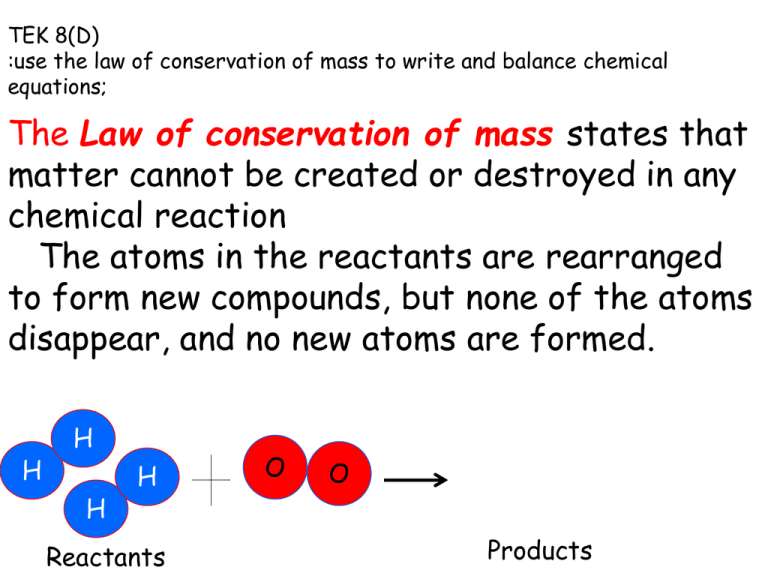Law of Conservation of Mass
advertisement

TEK 8(D) :use the law of conservation of mass to write and balance chemical equations; The Law of conservation of mass states that matter cannot be created or destroyed in any chemical reaction The atoms in the reactants are rearranged to form new compounds, but none of the atoms disappear, and no new atoms are formed. H H H H Reactants O O Products A chemical equation identifies the starting and ending chemicals as reactants and products: reactants products Formation of water 2H2 + O2 2H20 A chemical equation is balanced when it reflects the conservation of mass. Graphic: http://www.chemistry.ohiostate.edu/betha/nealChemBal/ The same number of each kind of atom must be on the left side of the arrow as are on the right side when an equation is balanced. Al Al Al Al O O O O O Al O Al O O O O Al O Al O Balancing an equation: 2 H2 H H + O2 O O 2 H2O H O H Second:Inventory First: Determinethe which atoms atoms on both are not sides equal of the and add coefficients yield arrow to balance these atoms. Hydogen Hydogen 4H 2 atoms H atoms 42 HH atoms atoms atoms atoms are are =≠ 2O 2 atoms O atoms Oxygen Oxygen 21 OO atoms atom atoms are are≠== atoms atoms are When a coefficient isinventory, added you must multiply After redoing the add coefficients Oxygen, as a product, must be multiplied by 2. This is now a balanced equation allto in theother compound byWith this each number. balanced atoms. additional Aatoms coefficient is placed in front of the Redo the inventory coefficient the inventory must be updated. compounds that contains O. So: Chemical equations are balanced, when the numbers and kinds of atoms on each side of the reaction arrow are equal. H H H H O H O O H H Reactants Products 4 Hydrogen 4 Hydrogen 2 Oxygen 2 Oxygen H O Because atoms are conserved, the mass of the reactants in the chemical reaction is equal to the mass of the products. H2 + F2 H H F 2g + 38g 40g 2 HF H F F H F = 2( 20g) = 40g Reactants Products 40 g 40 g The Law of Conservation of Mass allows the calculation of the reactants or products. If 27.0 g of mercuric oxide (the red solid compound) is heated and completely decomposes to give the elements oxygen and mercury. 2.0 g of oxygen are produced. How many grams of mercury are produced? mercuric oxide mercury + oxygen HgO Hg + O2 2.0 g O2 27.0 g HgO ? g Hg 27 g HgO = 2 g O2 + ? Hg = 25 g Hg Reactants Products Which of the following chemical reactions indicate that mass in conserved? A. Mg + Cl2 2 MgCl B. 2 Ca + O2 2 CaO C. Zn + S 2 ZnS D. C + O2 2 CO Because atoms must be equal on each side of the equation: The correct answer is B Ca Ca O O O Ca Ca O HCl →→ MgCl 2 Mg + 2 HCl MgCl + 2H2 2 +2 H • When the above equation is balanced, the coefficient for magnesium is — • A 0 • B 1 The correct • C 2 answer is C • D 4 Suppose 100 g of iron metal rusts. We weigh the rust and find that the rust has a mass of 143 g. What mass of oxygen reacted with the iron? A. 243 g B. 57 g C. 100 g D 43 g Iron + Oxygen Rust • 100 g + ?g 143g • What mass of oxygen is needed? 43 g Oxygen Choice D





